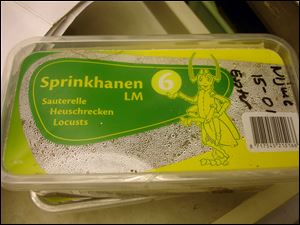
UN: Put more nutritious insects in your diet; Coming soon to your yogurt, cocktails, pills
5/13/2013
The U.N. has new weapons to fight hunger, boost nutrition and reduce pollution, and they might be crawling or flying near you right now: edible insects.
ASSOCIATED PRESS

The U.N. has new weapons to fight hunger, boost nutrition and reduce pollution, and they might be crawling or flying near you right now: edible insects.
ROME — The U.N. has new weapons to fight hunger, boost nutrition and reduce pollution, and they might be crawling or flying near you right now: edible insects.
The Food and Agriculture Organization today hailed the likes of grasshoppers, ants and other members of the insect world as an underutilized food for people, livestock and pets.
A 200-page report, released at a news conference at the U.N. agency’s Rome headquarters, says 2 billion people worldwide already supplement their diets with insects, which are high in protein and minerals, and have environmental benefits.
Insects are “extremely efficient” in converting feed into edible meat, the agency said. On average, they can convert 2 kilograms (4.4 pounds) of feed into 1 kilogram (2.2 pounds) of insect mass. In comparison, cattle require 8 kilograms (17.6 pounds) of feed to produce a kilo of meat.
Some edible insect information in bite-sized form:
WHO EATS INSECTS NOW?
Two billion people do, largely in Asia, Africa and Latin America, the Rome-based U.N. Food and Agriculture Organization said Monday as it issued a report exploring edible insect potential.
Some insects may already be in your food (and this is no fly-in-my-soup joke.) Demand for natural food coloring as opposed to artificial dyes is increasing, the agency’s experts say. A red coloring produced from the cochineal, a scaled insect often exported from Peru, already puts the hue in a trendy Italian aperitif and an internationally popular brand of strawberry yogurt. Many pharmaceutical companies also use colorings from insects in their pills.

Eva Muller, Director of United Nations Food and Agriculture Organization Forest Economic Policy and Products Division, speaks during a press conference today in Rome to launch a report on edible insects.
PACKED WITH PROTEIN, FULL OF FIBER
Scientists who have studied the nutritional value of edible insects have found that red ants, small grasshoppers and some water beetles pack (gram-per-gram or ounce-per-ounce) enough protein to rank with lean ground beef while having less fat per gram.
Bored with bran as a source of fiber in your diet? Edible insects can oblige, and they also contain useful minerals such as iron, magnesium, phosphorous, selenium and zinc.
WHICH TO CHOOSE?
Beetles and caterpillars are the most common meals among the more than 1,900 edible insect species that people eat. Other popular insect foods are bees, wasps, ants, grasshoppers, locusts and crickets. Less popular are termites and flies, according to U.N. data.
ECO-FRIENDLY
Insects on average can convert 2 kilograms (4.4 pounds) of feed into 1 kilogram (2.2 pounds) of edible meat. In comparison, cattle require 8 kilograms (17.6 pounds) of feed to produce a kilogram of meat. Most insects raised for food are likely to produce fewer environmentally harmful greenhouse gases than livestock, the U.N. agency says.
DON’T SWAT THE INCOME

A packaging containing locusts for sale in the Netherlands.
Edible insects are a money-maker. In Africa, four big water bottles filled with grasshoppers can fetch a gatherer 15 euros ($20). Some caterpillars in southern Africa and weaver ant eggs in Southeast Asia are considered delicacies and command high prices.
Insect-farms tend to be small, serving niche markets like fish bait businesses. But since insects thrive across a wide range of locations — from deserts to mountains — and are highly adaptable, experts see big potential for the insect farming industry, especially those farming insects for animal feed. Most edible insects are now gathered in forests.
LET A BUG DO YOUR RECYLING
A 3 million euro ($4 million) European Union-funded research project is studying the common housefly to see if a lot of flies can help recycle animal waste by essentially eating it while helping to produce feed for animals such as chickens. Right now farmers can only use so much manure as fertilizer and many often pay handsome sums for someone to cart away animal waste and burn it.
A South African fly factory that rears the insects en masse to transform blood, guts, manure and discarded food into animal feed has won a $100,000 U.N.-backed innovation prize.